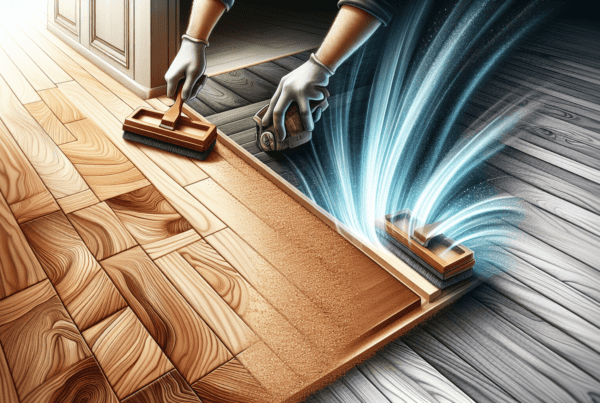Nestled in the heart of Wellington, our team at Elite Timber Floor Sanding & Finishing Services takes pride in breathing new life into worn-out wooden floors. With years of experience under our belt, we understand how important it is to maintain the charm and integrity of timber floors, ensuring they stand the test of time. Our expertise in sanding and finishing transforms any space, making floors not just surfaces to walk on but a statement piece that reflects the care and quality we dedicate to our craft. Join us as we explore the infinite possibilities that come with beautifully maintained timber floors, enhancing the beauty and value of your space.
Understanding Timber Floor Sanding
Definition of floor sanding
Floor sanding is a vital refurbishment technique that we use on wooden floors to remove the top surfaces of a timber floor by sanding it with abrasive materials. It’s a process we often undertake when our floors show signs of wear and tear, such as scratches, dents, and discoloration. Sanding effectively removes these imperfections, revealing a smoother surface beneath.
The importance of sanding in floor restoration
Sanding plays a crucial role in floor restoration. It’s the step that precedes the application of finishes, ensuring the wood absorbs the finishing product evenly. By sanding our floors, we also increase their durability, reduce the chances of splinters, and prepare them for staining or sealing. This process essentially breathes new life into our timber floors, making them look brand new.
Different stages of timber floor sanding
The process of timber floor sanding is carried out in several stages, starting with the removal of old coatings and finishes. We then move to coarse sanding, which removes significant imperfections and levels the floor. This is followed by medium sanding, which smooths out the surface, and finally, fine sanding, which prepares the floor for the finishing touches. Each stage uses different grit sizes, gradually working towards a finer finish.
The Benefits of Professional Timber Floor Sanding
Extended lifespan of timber floors
By opting for professional timber floor sanding, we ensure that our floors are sanded evenly and thoroughly, which can significantly extend their lifespan. Professionals also know exactly how much of the surface to remove, preserving the integrity of the timber for longer.
Enhancement of natural wood beauty
Professional sanding techniques bring out the natural beauty and grain of our wood floors. This enhancement not only adds a warm aesthetic appeal to our spaces but also highlights the unique character of our timber floors.
Improvement in indoor air quality
Sanding removes old coatings that may harbor dust and allergens, improving the air quality within our homes. A well-sanded and finished floor also accumulates less dust, making it easier to maintain a cleaner and healthier living environment.
Increase in property value
Well-maintained timber floors are a sought-after feature in any property. Professionally sanded and finished floors can significantly increase the value of our homes, making it a wise investment for the future.
Choosing the Right Timber Floor Sanding Service in Wellington
Criteria for selecting a sanding service
When choosing a timber floor sanding service in Wellington, it’s important to consider their experience, reputation, and the quality of their work. We look for services that use state-of-the-art equipment and eco-friendly materials. It’s also crucial to check their licensing and insurance to ensure they meet professional standards.
Questions to ask potential service providers
Before hiring a service provider, we ask about their process, including the type of equipment and finishes they use. Inquiring about their turnaround time and whether they offer a guarantee on their work can also provide us with peace of mind.
Comparing quotes and services
We recommend obtaining quotes from several providers to compare prices. However, we shouldn’t make our decision based solely on cost. Assessing the overall value, including the quality of work and materials, is essential to choosing the right service for our needs.
The Timber Floor Sanding Process
Initial assessment and preparation
The process typically begins with a thorough assessment of our timber floors to identify any major issues that need addressing. The area is then cleared and prepared, with nails being countersunk and any gaps being filled to ensure a smooth sanding process.
Sanding techniques and equipment used
Professional services use a range of sanding equipment, from belt sanders for the initial heavy-duty sanding to orbital sanders for the finer work. They employ different techniques to achieve an even and smooth finish across the entire floor.
Detailing and fine sanding stages
After the main sanding stages are completed, detailing work focuses on areas that are harder to reach, such as edges and corners. The final fine sanding stage prepares the floor for the finishing touches, ensuring it’s perfectly smooth.
Finishing Services After Sanding
Types of finishes available
There are several types of finishes we can choose from, including varnishes, oils, and waxes. Each offers a different level of protection and aesthetic appeal, from glossy to matte finishes.
Choosing the right finish for your floor
Selecting the right finish depends on several factors, including the type of wood, the desired look, and the level of traffic the area receives. We also consider the maintenance requirements of each finish type.
Application methods and techniques
Professional finishers use various application methods, such as brushing, rolling, or spraying, depending on the type of finish and the specific requirements of the floor. Techniques may also vary to achieve a uniform coat and optimal drying conditions.
Drying and curing times
Each type of finish has its own drying and curing times. It’s important to follow the recommended waiting periods before using the floor to ensure the finish sets properly and provides lasting protection.
Maintenance Tips for Sanded and Finished Timber Floors
Regular cleaning practices
Maintaining our floors involves regular cleaning with a soft broom or a vacuum cleaner designed for hardwood floors. Using a damp mop with a mild detergent can also keep our floors looking their best.
Preventative measures to avoid damage
To prevent scratches and wear, we place protective pads under furniture and avoid walking on the floors with high heels or abrasive shoes. It’s also advisable to keep pets’ nails trimmed and to use area rugs in high-traffic zones.
When to re-sand and re-finish
Over time, even well-maintained floors may require re-sanding and re-finishing. Signs that it’s time include visible wear, deep scratches, or when the floor starts to lose its sheen. Typically, floors may need re-sanding every 10 to 15 years, depending on their condition and use.
The Cost of Timber Floor Sanding and Finishing Services
Factors that influence cost
The cost of sanding and finishing services can vary based on the size of the area, the condition of the floors, and the type of finish selected. Other factors, such as the need for repairs or the removal of existing finishes, can also affect the price.
Estimating your project budget
To estimate the budget for our project, we consider all the variables, including preparation work, the number of sanding stages required, and the cost of the finishes. Getting detailed quotes from multiple providers can help us form a realistic budget.
Saving money without compromising quality
While it’s tempting to choose the cheapest option, focusing on value is crucial. We look for services that offer a good balance between cost and quality, ensuring we don’t compromise the longevity and appearance of our floors.
Case Studies: Before and After Sanding and Finishing
Residential flooring transformations
Many homeowners have seen remarkable transformations in their homes following professional sanding and finishing services. Dull, scratched floors regain their shine and warmth, enhancing the overall ambiance of the living spaces.
Commercial spaces renewal
In commercial settings, such as offices and retail spaces, floor restoration not only revitalizes the look of the area but also contributes to a more welcoming environment for customers and employees.
Customer testimonials
Positive feedback from satisfied customers attests to the difference professional sanding and finishing can make. From improved aesthetics to increased durability, the benefits are clear in both residential and commercial contexts.
Choosing Eco-Friendly Sanding and Finishing Options
Sustainable materials and practices
We prioritize services that use sustainable materials and eco-friendly practices, such as dustless sanding equipment and low-VOC finishes. These options reduce environmental impact and contribute to healthier indoor air quality.
Benefits of eco-friendly finishes
Eco-friendly finishes not only protect our floors but also safeguard our health and the environment. They emit fewer toxic chemicals, making them a safer choice for homes with children, pets, or individuals with allergies.
Finding services that offer green solutions
When selecting a timber floor sanding and finishing service in Wellington, we seek out those committed to sustainability. Companies that offer eco-friendly options are often more attentive to the details that ensure a high-quality and environmentally responsible finish.
FAQs About Timber Floor Sanding and Finishing
How long does the sanding and finishing process take?
The duration can vary depending on the size of the project, the condition of the floors, and the type of finishes used. Generally, the process can take anywhere from a few days to a week.
Can all timber floors be sanded and refinished?
Most timber floors can be sanded and refinished, but there are exceptions. Floors that are too thin or have been sanded down multiple times may not be suitable. An initial assessment can determine if sanding is an option.
How to maintain the floor after sanding and finishing?
Regular cleaning and maintenance, such as prompt spill cleanups and the use of appropriate cleaning products, can keep our floors looking their best. We also avoid dragging furniture and use protective pads to prevent scratches.
Dealing with allergies and dust during the sanding process
Choosing a service that uses dustless sanding equipment can significantly reduce the amount of airborne dust, minimizing the impact on indoor air quality and making the process safer for those with allergies.







